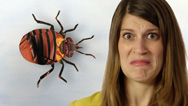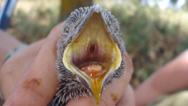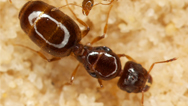Power From Fish Scales?
- By Anna Rothschild
- Posted 12.01.16
- NOVA
What should you do with stinky old fish skins? How about powering your cellphone? Learn more in this episode of Gross Science.
Transcript
Power From Fish Scales?
Posted: December 1, 2016
What should you do with stinky old fish skins? How about powering your cellphone?
I’m Anna Rothschild, and this is Gross Science.
No matter how much you love fish, you’ll likely toss the skin. But why let a good thing go to waste? Turns out, a team of physicists has found a way to make fish scales into tiny electrical generators.
So, how does it work? Well, fish scales, along with bones, cartilage, and tendons, are all made of a protein called collagen. Collagen is a “piezoelectric” material, which means that it creates an electric charge in response to a mechanical stress, like pressure. You can tap it, slap it, squeeze it, breeze it; no matter what, it’ll make electrical energy. You might’ve seen piezoelectricity at work this summer; it’s what makes barbecue lighters spark. When you press the trigger, it strikes a piezoelectric quartz crystal, which in turn generates high voltage that creates a spark and lights the fuel.
The cool thing about these materials is that they work in reverse, too. Feeding a piezoelectric material electricity can make it change its shape or vibrate. This is how the tiny speakers in those novelty cards work. You open the card, close the circuit, and send electricity to a piezoelectric diaphragm. It deforms its shape and vibrates at specific frequencies, creating sound waves.
But back to fish skins. To make a tiny generator, the team collects carp scales from a processing plant. They take these scales and put them in a solution that makes them flexible and transparent. Add electrodes and laminate the whole thing, and you have a biodegradable energy harvester. Potential uses include small electronics that you can bend, see through, and even eat. And it’s all because of fish skin. It’s basically the ultimate upcycling project!
I should put that on my Pinterest board…
Perhaps the coolest thing about the microgenerator is its high sensitivity to pressure. Just tapping four of them can power 50 LEDs. It’s able to pick up mechanical energy from ambient body movements, wind flow, and even sound vibrations. You could power your phone just by walking—no charger needed.
And because it’s made of collagen, the generator could be “biocompatible.” That means it’s not harmful to living tissue, like your skin or organs. After all, so much of your body is already made of collagen. So, beyond handheld electronics, physicists are exploring medical applications like insulin pumps or pacemakers. The tiny movement of your heart beating would provide enough mechanical energy to keep the generator going. Which is super cool! … As long as you can get over having dead fish parts in your body.
Ew.
Credits
PRODUCTION CREDITS
- Host, Producer
- Anna Rothschild
- Writer, Researcher, Videographer, Editor
- Mark Gartsbeyn
- Good Time Charlie b
- Music Provided by APM Original Footage
- ©WGBH Educational Foundation 2016
FOOTAGE AND STILLS
- Images of collagen and scientists with generator
- Courtesy Dr. Dipankar Mandal
- X-ray real heart beating in action
- Shutterstock/SVTeam
- Dead Fish
- Wikimedia Commons/Jbellegaribay
- Cook Fish on White Ceramic Plate
- Pexels
- Sashimi
- Pixabay/PublicDomainPictures
- Tuna fish sandwiches for the National School Lunch Program (1)
- Wikimedia Commons/U.S. Department of Agriculture
- Fish Sticks (11833724893)
- Wikimedia Commons/EHRENBERG Kommunikation
- Fish and Chips
- PublicDomainPictures.net/George Hodan
- Salade nicoise
- Wikimedia Commons/Canterel
- Image from page 442 of “Encylopédie d’historie naturelle” (Fish illustration)
- Flickr/Internet Archive Book Images
- Genga 05
- Wikimedia Commons/Fuelbottle~commonswiki
- The horse, its treatment in health and disease with a complete guide to breeding, training and management (1906) (14749262516)
- Wikimedia Commons/J. Wortley Axe/Internet Archive Book Images
- Wax(?) model of a dissected foot, showing tendons. Pencil an Wellcome V0008281
- Wikimedia Commons/Wellcome Images
- Catla catla
- Wikimedia Commons/Khalid Mahmood
- Dead Carp J1
- Wikimedia Commons/Jamain
SFX
- Cockroaches
- Freesound/StateAardvark
(used with permission from author) - Squeak Pack/squeak_10
- Freesound/Corsica_S
- ELECTRIC_ZAP_001
- Freesound/JoelAudio
- Wink
- Freesound/bennychico11
- DrumRoll
- Wikimedia Commons/HolyGhostParty
- Whip Cracks/Whip Crack 01
- Freesound/CGEffex
- Squeaky Dog Toy
- Freesound/DANMITCH3LL
- Household/Extractor Fan 02
- Freesound/JarredGibb
- Produced by WGBH for PBS Digital Studios
POSTER IMAGE
- Catla catla
- Wikimedia Commons/Khalid Mahmood
Sources
Want more info?
(Original article) High-performance bio-piezoelectric nanogenerator made with fish scales:
http://bit.ly/2gdOVvU
Related Links
-

Gross Science
Bizarre stories from the slimy, smelly, creepy world of science.
-

Defensive Vomiting
If you're attacked you could run away, fight back... or you could barf.
-

What Does an Ant Sound Like?
Ant language sounds wacky—and can be hacked.
-

The Chemistry of Skunk Spray
How do you get rid of skunk odor? Don't use tomato juice... use chemistry!

